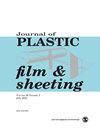制备多孔环保PCL膜的固态共混:过滤应用的潜力
IF 1.5
4区 材料科学
Q3 MATERIALS SCIENCE, COATINGS & FILMS
引用次数: 0
摘要
低温研磨是一种很有前途的方法,用于制造聚合物共混物和复合粉末原料,用于各种后续制造工艺。本研究以聚ε-己内酯(PCL)为原料,采用冷磨/热压/多孔浸出法制备了可生物降解的多孔膜。采用冷磨法制备了6种不同模型成分的粉末混合物;此后,胶片被热压制成。聚环氧乙烷(PEO)和盐被用作环保的多孔剂,在这些混合物中溶解在水中以引入薄膜的孔隙度。研究了木屑(WSD)和明矾作为填料对膜的亲水性、机械性能和抗菌性能的影响。研究了微滤膜的形态、亲水性、力学性能和过滤效率,并与商业实验室微滤膜进行了比较。扫描电镜分析显示,所有成分的致密膜皮,以及层状多孔结构。平均孔径半径为0.15 ~ 0.21 μm,在MF孔径范围内。水接触角测量值平均为70°,并且随着WSD和明矾的加入而减小,表明亲水性增强。拉伸试验结果表明,随着孔隙率的增加和WSD的加入,材料的力学性能有所下降。明矾(≥10 wt%)的加入导致膜脆性。从纯水通量和降低纺织废水浊度两方面对其过滤性能进行了评价,并与工业膜进行了比较。总之,本研究成功地引入了一种简便、通用的膜制造新方法。本文章由计算机程序翻译,如有差异,请以英文原文为准。
Solid-state blending for the preparation of porous eco-friendly PCL membranes: Potential for filtration applications
Cryomilling is a promising method for fabricating polymeric blend and composite powder raw materials for various subsequent manufacturing processes. In this study, biodegradable porous membranes were fabricated from poly (ε-caprolactone) (PCL) using the cryomilling/hot pressing/porogen leaching approach. Powder mixtures of six different model compositions were compounded by cryomilling; thereafter, films were fabricated by hot-pressing. Poly (ethylene-oxide) (PEO) and salt were utilized as eco-friendly porogens in these mixtures, which were dissolved in water to introduce porosity in the films. Wood sawdust (WSD) and alum were investigated as fillers potentially capable of manipulating the hydrophilicity, mechanical and antimicrobial properties of the membranes. The morphological, hydrophilicity, mechanical, and filtration efficiency properties were explored and compared to those of commercial laboratory microfiltration (MF) membranes. SEM analysis revealed dense membrane skins for all compositions, along with lamellar porous structures. Mean pore radius ranged from 0.15 to 0.21 μm, which is within the MF pore size range. Water contact angle measurements averaged 70° and decreased with the addition of WSD and alum, indicating increased hydrophilicity. Tensile test results showed a decrease in mechanical properties, with higher porosities and with the addition of WSD. Adding alum (≥10 wt%) resulted in embrittled membranes. Filtration performance was evaluated in terms of pure water flux and turbidity reduction for textile wastewater, and it compared favorably to commercial membranes. In conclusion, this study has successfully introduced a new facile and versatile membrane fabrication approach.
求助全文
通过发布文献求助,成功后即可免费获取论文全文。
去求助
来源期刊

Journal of Plastic Film & Sheeting
工程技术-材料科学:膜
CiteScore
6.00
自引率
16.10%
发文量
33
审稿时长
>12 weeks
期刊介绍:
The Journal of Plastic Film and Sheeting improves communication concerning plastic film and sheeting with major emphasis on the propogation of knowledge which will serve to advance the science and technology of these products and thus better serve industry and the ultimate consumer. The journal reports on the wide variety of advances that are rapidly taking place in the technology of plastic film and sheeting. This journal is a member of the Committee on Publication Ethics (COPE).
 求助内容:
求助内容: 应助结果提醒方式:
应助结果提醒方式:


